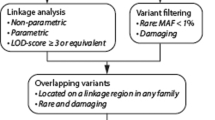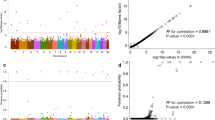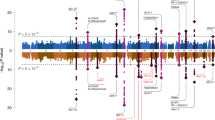Abstract
Previous linkage analyses of intracranial aneurysm (IA) have proposed several genetic susceptibility loci; however, some loci remain contradictory. The objective of this study was to confirm these loci in a Japanese population using allelic and haplotype association analyses. We set high-density single nucleotide polymorphism markers in previously suggested IA loci and conducted an association analysis in 29 cases and 35 controls from a small community in Akita, Japan. Genotyping was carried out using the GeneChip 10 K mapping array, and the association analysis was performed using GeneSpring GT2 software. The result was confirmed in a replication cohort consisting of 237 cases and 253 controls from all over Japan. Only one variant, rs767603, at chromosome 14q23, was significantly associated with IA, both in allelic analysis (p = 0.00017, Bonferroni-corrected p = 0.021) and haplotype analysis (p = 0.00178, Bonferroni-corrected p = 0.048). This association was confirmed in the replication cohort (p = 0.0046 for allelic association, p = 0.0060 for haplotype association). Our findings confirm 14q23 to be a susceptibility locus for intracranial aneurysm.
Similar content being viewed by others
Log in or create a free account to read this content
Gain free access to this article, as well as selected content from this journal and more on nature.com
or
References
Adeyemo AA, Chen G, Chen Y, Rotimi C (2005) Genetic structure in four West African population groups. BMC Genet 6:38
Akagawa H, Tajima A, Sakamoto Y, Krischek B, Yoneyama T, Kasuya H, Onda H, Hori T, Kubota M, Machida T, Saeki N, Hata A, Hashiguchi K, Kimura E, Kim CJ, Yang TK, Lee JY, Kimm K, Inoue I (2006) A haplotype spanning two genes, ELN and LIMK1, decreases their transcripts and confers susceptibility to intracranial aneurysms. Hum Mol Genet 15:1722–1734
Berthelemy-Okazaki N, Zhao Y, Yang Z, Camp NJ, Farnham J, Parker D, Tsuruda J, Macdonald J, Zhang K, Cannon-Albright LA (2005) Examination of ELN as a candidate gene in the Utah intracranial aneurysm pedigrees. Stroke 36:1283–1284
Farnham JM, Camp NJ, Neuhausen SL, Tsuruda J, Parker D, MacDonald J, Cannon-Albright LA (2004) Confirmation of chromosome 7q11 locus for predisposition to intracranial aneurysm. Hum Genet 114:250–255
Hao K, Li C, Rosenow C, Wong WH (2004) Detect and adjust for population stratification in population-based association study using genomic control markers: an application of Affymetrix Genechip Human Mapping 10 K array. Eur J Hum Genet 12:1001–1006
Hao K, Di X, Cawley S (2007) LdCompare: rapid computation of single- and multiple-marker r2 and genetic coverage. Bioinformatics 23:252–254
Henkes H, Fischer S, Weber W, Miloslavski E, Felber S, Brew S, Kuehne D (2004) Endovascular coil occlusion of 1811 intracranial aneurysms: early angiographic and clinical results. Neurosurgery 54:268–80; discussion 280–285
Hofer A, Hermans M, Kubassek N, Sitzer M, Funke H, Stogbauer F, Ivaskevicius V, Oldenburg J, Burtscher J, Knopp U, Schoch B, Wanke I, Hubner F, Deinsberger W, Meyer B, Boecher-Schwarz H, Poewe W, Raabe A, Steinmetz H, Auburger G (2003) Elastin polymorphism haplotype and intracranial aneurysms are not associated in Central Europe. Stroke 34:1207–1211
Hu N, Wang C, Hu Y, Yang HH, Giffen C, Tang ZZ, Han XY, Goldstein AM, Emmert-Buck MR, Buetow KH, Taylor PR, Lee MP (2005) Genome-wide association study in esophageal cancer using genechip mapping 10 K array. Cancer Res 65:2542–2546
Inagawa T (2001) Trends in incidence and case fatality rates of aneurysmal subarachnoid hemorrhage in Izumo City, Japan, between 1980–1989 and 1990–1998. Stroke 32:1499–1507
Inoue K, Mineharu Y, Inoue S, Yamada S, Matsuda F, Nozaki K, Takenaka K, Hashimoto N, Koizumi A (2006) Search on chromosome 17 centromere reveals TNFRSF13B as a susceptibility gene for intracranial aneurysm. A preliminary study. Circulation 113(16):2002–10
International Study of Unruptured Intracranial Aneurysms Investigators (1998) Unruptured intracranial aneurysms––risk of rupture and risks of surgical intervention. International Study of Unruptured Intracranial Aneurysms Investigators. N Engl J Med 339:1725–1733
Krex D, Konig IR, Ziegler A, Schackert HK, Schackert G (2004) Extended single nucleotide polymorphism and haplotype analysis of the elastin gene in Caucasians with intracranial aneurysms provides evidence for racially/ethnically based differences. Cerebrovasc Dis 18:104–110
Krischek B, Narita A, Akagawa H, Kasuya H, Tajima A, Onda H, Yoneyama T, Hori T, Inoue I (2006) Is there any evidence for linkage on chromosome 17cen in affected Japanese sib-pairs with an intracranial aneurysm? J Hum Genet 51:491–494
Longstreth WT Jr, Nelson LM, Koepsell TD, van Belle G (1993) Clinical course of spontaneous subarachnoid hemorrhage: a population-based study in King County, Washington. Neurology 43:712–718
Mineharu Y, Inoue K, Inoue S, Yamada S, Nozaki K, Takenaka K, Hashimoto N, Koizumi A (2006) Association analysis of common variants of ELN, NOS2A, APOE and ACE2 to intracranial aneurysm. Stroke 37:1189–1194
Mineharu Y, Inoue K, Inoue S, Yamada S, Nozaki K, Hashimoto N, Koizumi A (2007) Model-based linkage analyses confirm chromosome 19q13.3 as a susceptibility locus for intracranial aneurysm. Stroke 38:1174–1178
Nahed BV, Seker A, Guclu B, Ozturk AK, Finberg K, Hawkins AA, Diluna ML, State M, Lifton RP, Gunel M (2005) Mapping a Mendelian form of intracranial aneurysm to 1p34.3–p36.13. Am J Hum Genet 76:172–179
Olson JM, Vongpunsawad S, Kuivaniemi H, Ronkainen A, Hernesniemi J, Ryynanen M, Kim LL, Tromp G (2002) Search for intracranial aneurysm susceptibility gene(s) using Finnish families. BMC Med Genet 3:7
Onda H, Kasuya H, Yoneyama T, Takakura K, Hori T, Takeda J, Nakajima T, Inoue I (2001) Genomewide-linkage and haplotype-association studies map intracranial aneurysm to chromosome 7q11. Am J Hum Genet 69:804–819
Ozturk AK, Nahed BV, Bydon M, Bilguvar K, Goksu E, Bademci G, Guclu B, Johnson MH, Amar A, Lifton RP, Gunel M (2006) Molecular genetic analysis of two large kindreds with intracranial aneurysms demonstrates linkage to 11q24–25 and 14q23–31. Stroke 37:1021–1027
Pritchard JK, Rosenberg NA (1999) Use of unlinked genetic markers to detect population stratification in association studies. Am J Hum Genet 65:220–228
Raaymakers TW, Rinkel GJ, Limburg M, Algra A (1998) Mortality and morbidity of surgery for unruptured intracranial aneurysms: a meta-analysis. Stroke 29:1531–1538
Ronkainen A, Miettinen H, Karkola K, Papinaho S, Vanninen R, Puranen M, Hernesniemi J (1998) Risk of harboring an unruptured intracranial aneurysm. Stroke 29:359–362
Roos YB, Pals G, Struycken PM, Rinkel GJ, Limburg M, Pronk JC, van den Berg JS, Luijten JA, Pearson PL, Vermeulen M, Westerveld A (2004) Genome-wide linkage in a large Dutch consanguineous family maps a locus for intracranial aneurysms to chromosome 2p13. Stroke 35:2276–2281
Ruigrok YM (2006) From intracranial aneurysm to subarachnoid hemorrhage: unraveling the genetics, 1st edn. Proefschrift, Universiteit Utrecht
Ruigrok YM, Rinkel GJ, van’t Slot R, Wolfs M, Tang S, Wijmenga C (2006a) Evidence in favor of the contribution of genes involved in the maintenance of the extracellular matrix of the arterial wall to the development of intracranial aneurysms. Hum Mol Genet 15:3361–3368
Ruigrok YM, Rinkel GJ, Wijmenga C (2006b) The versican gene and the risk of intracranial aneurysms. Stroke 37:2372–2374
Schievink WI, Schaid DJ, Michels VV, Piepgras DG (1995) Familial aneurysmal subarachnoid hemorrhage: a community-based study. J Neurosurg 83:426–429
Tregouet DA, Escolano S, Tiret L, Mallet A, Golmard JL (2004) A new algorithm for haplotype-based association analysis: the stochastic-EM algorithm. Ann Hum Genet 68:165–177
van der Voet M, Olson JM, Kuivaniemi H, Dudek DM, Skunca M, Ronkainen A, Niemela M, Jaaskelainen J, Hernesniemi J, Helin K, Leinonen E, Biswas M, Tromp G (2004) Intracranial aneurysms in Finnish families: confirmation of linkage and refinement of the interval to chromosome 19q13.3. Am J Hum Genet 74:564–571
Verlaan DJ, Dube MP, St-Onge J, Noreau A, Roussel J, Satge N, Wallace MC, Rouleau GA (2006) A new locus for autosomal dominant intracranial aneurysm, ANIB4, maps to chromosome 5p15.2–14.3. J Med Genet 43:e31
Weinsheimer S, Goddard KA, Parrado AR, Lu Q, Sinha M, Lebedeva ER, Ronkainen A, Niemela M, Khusnutdinova EK, Khusainova RI, Helin K, Jaaskelainen JE, Sakovich VP, Land S, Kuivaniemi H, Tromp G (2007) Association of kallikrein gene polymorphisms with intracranial aneurysms. Stroke 38:2670–2676
Yamada S, Koizumi A, Iso H, Wada Y, Watanabe Y, Date C, Yamamoto A, Kikuchi S, Inaba Y, Toyoshima H, Kondo T, Tamakoshi A (2003a) Risk factors for fatal subarachnoid hemorrhage: the Japan Collaborative Cohort Study. Stroke 34:2781–2787
Yamada S, Utsunomiya M, Inoue K, Nozaki K, Miyamoto S, Hashimoto N, Takenaka K, Yoshinaga T, Koizumi A (2003b) Absence of linkage of familial intracranial aneurysms to 7q11 in highly aggregated Japanese families. Stroke 34:892–900
Yoneyama T, Kasuya H, Onda H, Akagawa H, Hashiguchi K, Nakajima T, Hori T, Inoue I (2004) Collagen type I alpha2 (COL1A2) is the susceptible gene for intracranial aneurysms. Stroke 35:443–448
Acknowledgments
This work was supported by a grant from the Ministry of Education, Science, Sports, and Culture of Japan to AK (Tokutei Kenkyu: 15012231, 16012232, 17019034 and 18018022) and a grant from the Japan Society for the Promotion of Science to AK (Kiban Kenkyu A: 14207016 and S: 17109007). YM is a Research Fellow (18–2738) of the Japan Society for the Promotion of Science. We thank Norio Matsuura, and Eriko Mori for technical assistance, and the following doctors for patient recruitment and help in ascertaining MRA examinations: Shinsuke Tominaga, Hiroshi Hasegawa, and Toshihiko Inui (Tominaga Hospital), Shyunichi Yoneda and Yoshito Naruo (Nihonbashi Hospital), Yoo Kang (Ohno Kinen Hospital), Hiroyasu Yamakawa (Gero-spring Hospital), Atsushi Kawarazaki (Kawarazaki Hospital), Masayuki Matsuda (Shiga University of Medical Science), Michiyasu Suzuki and Sadahiro Nomura (Yamaguchi University School of Medicine), Takaaki Kaneko and Takuya Moriwaki (Hikone Municipal Hospital), Nozomu Murai (Otowa Hospital), Tomoo Tokime, Shoichi Tani and Susumu Kanemoto (Tenri Hospital), Tatsuhito Yamagami (Kyoto Kizugawa Hospital), Motoharu Fujii (International University of Health and Welfare), Hikaru Ohishi and Kiminari Ohtaka, Junko Sasaki, Koki Iwaya, and Masaya Iwakawa (Senboku Kumiai Sougou Hospital), Kenji Kikuchi and Yutaka Yamazaki (Yuri Kumiai Sougou Hospital), Shiro Nagasawa and Nobuhisa Mabuchi (Soseikai General Hospital), Yasuhiko Tokuriki (Fukui Red Cross Hospital), Sen Yamagata (Kurashiki Central Hospital), Kenji Hashimoto (Hyogo Prefectural Tsukaguchi Hospital), Atsushi Okumura (Takeda Hospital) Yoshihiko Uemura (Kyoto City Hospital), Kiyohiro Houkin and Osamu Honmou (Sapporo Medical University School of Medicine), Izumi Nagata (Nagasaki University School of Medicine), Ichiro Nakahara and Toshio Higashi (Kokura Memorial Hospital), and Takashi Yoshizawa and Kenjiro Ito (Yokohama Shintoshi Neurosurgical Hospital), Shigeki Yamada (Shiga Medical Center for Adults), Jun Takahashi, Nobuhiro Mikuni, Ken-ichiro Kikuta, Yasushi Takagi, and Yo Kishi (Kyoto University Graduate School of Medicine).
Author information
Authors and Affiliations
Corresponding author
Rights and permissions
About this article
Cite this article
Mineharu, Y., Inoue, K., Inoue, S. et al. Association analyses confirming a susceptibility locus for intracranial aneurysm at chromosome 14q23. J Hum Genet 53, 325–332 (2008). https://doi.org/10.1007/s10038-008-0255-5
Received:
Accepted:
Published:
Issue date:
DOI: https://doi.org/10.1007/s10038-008-0255-5
Keywords
This article is cited by
-
A Review of the Genetics of Intracranial Berry Aneurysms and Implications for Genetic Counseling
Journal of Genetic Counseling (2017)
-
Genome-wide association study to identify genetic variants present in Japanese patients harboring intracranial aneurysms
Journal of Human Genetics (2010)
-
Molecular mechanism of cerebral aneurysm formation focusing on NF-κB as a key mediator of inflammation
Journal of Biorheology (2010)



